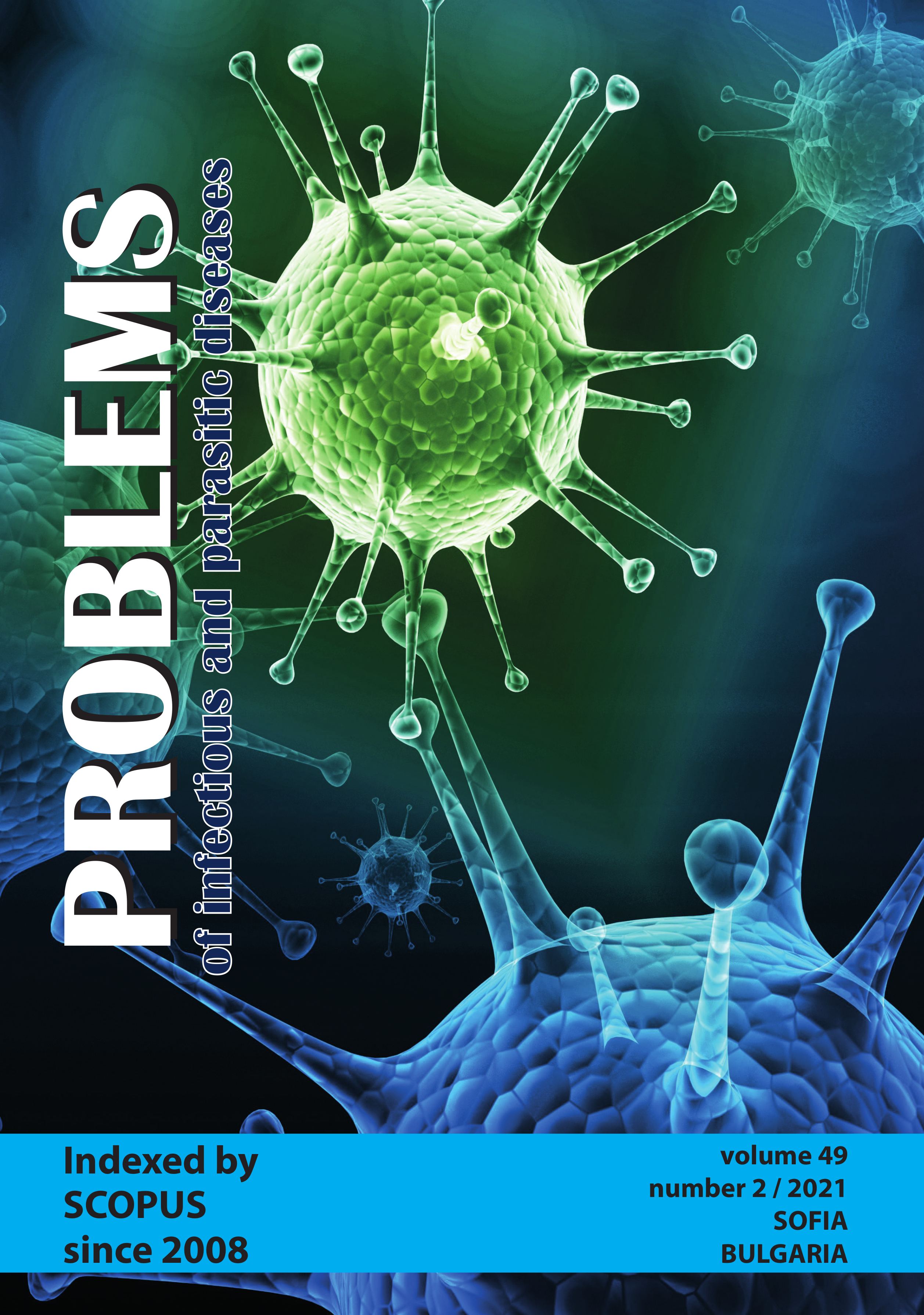RECORDS OF IXODID TICKS ON WILD BIRDS IN BULGARIA
DOI:
https://doi.org/10.58395/pipd.v49i2.65Keywords:
Ixodes ricinus, host preference, infestation rateAbstract
Background: Ixodid ticks are widely studied due to their epidemiological and epizootic importance. It is of great value to know vertebrate host preferences of ticks in order to understand their ecological relationships and distribution. Earlier studies report birds as important hosts of Ixodid tick and a total of 136 ticks species have been frequently found in birds worldwide. However, only few studies related to host preferences of ticks among wild birds in Bulgaria were conducted till now.
Aim: To obtain new data on the host preferences of ixodid ticks among wild birds at three locations in Bulgaria.
Material and methods: The study was conducted between 2010 – 2020 in three sites in Bulgaria – Biological Experimental Station Kalimok (Silistra region), near Brodilovo village (Burgas region), and the city of Sofia (city park). The birds were caught by mist nets and inspected for ticks. Ticks found were removed by fine tweezers or a special removal tool for ectoparasites. Tick identification was based on external morphological characteristics.
Results: A total of 2419 individual birds belonging to 78 species were examined. Of these, 70 individuals (16 species) carried ticks, thus representing 2.9% infestation rate. A total of 262 ticks were collected and identified as: Ixodes ricinus, Hyalomma marginatum, Haemaphysalis punctata, Hae. concinna, Hae. sulcata and two specimens could only be identified to the genus Haemaphysalis. Ixodes ricinus was the most commonly encountered tick (224/262), predominantly nymphs, followed by Hyalomma marginatum (27/262). The highest prevalence of tick infestation was observed among the Eurasian Blackbird, Turdus merula (28.6%), followed by the common nightingale, Luscinia megarhynchos (12.9%) and the common chaffinch, Fringilla coelebs (11.3%). These three bird species harboured the majority of ticks on their heads – some single individuals were infested by 10 up to 25 ticks per bird.
Conclusion: Ixodes ricinus was found as the predominant tick species in this study. Nymphs were the most frequently observed stage. Infesting both birds and humans, this tick species has the potential to spread local tick-borne infections.
Downloads
References
Socolovschi C, Mediannikov O, Raoult D, Parola P. The relationship between spotted fever group rickettsiae and ixodid ticks. Vet. Res. 2009; 40(2):1-20.
Kaiser MN, Hoogstraal H. Ticks (Ixodoidea) on migrating birds in Cyprus, fall 1967 and spring 1968, and epidemiological considerations. Bull Entomol Res. 1974; 64(1):97-110.
Hoogstraal H, Kaiser MN, Traylor MA, Guindys E, Gaber S. Ticks (Ixodidae) on Birds Migrating from Europe and Asia to Africa, 1959-61. Bull World Health Organ. 1963; 28(2):235-262.
Guglielmone AA, Nava S. Birds and hard ticks (Acari:Ixodidae), with discussions about hypotheses on tick evolution. FAVE Secc. Cienc. Vet. 2017; 16(1):13-29.
Ishiguro F, Takada N, Masuzawa T, Fukui T. Prevalence of Lyme Disease Borrelia spp. in ticks from migratory birds on the Japanese mainland. Appl Environ Microbiol. 2000; 66(3):982-986.
Hornok S, Kováts D, Csörgő T, Meli ML,Gönczi E, Hadnagy Z, et al. Birds as potential reservoirs of tick-borne pathogens: first evidence of bacteraemia with Rickettsia helvetica. Parasit Vectors 2014; 7(1):1-7.
Levy V. Distribution and Seasonal Activity in the Preimago Phases of the Ixodid Ticks in a Focus of Haemorrhagic Fever (Crimean Type). In: Daniel M., Rosický B. (eds) Proceedings of the 3rd International Congress of Acarology. Springer, Dordrecht. 1973; 609-610.
Georgieva G. In regard to species composition of the ticks of family Ixodidae on birds and small mammals from the coastal strip of Burgas region. Bulletin DDD. 1977; 8(3-4):66-73. In Bulgarian.
Kolev B, Ilieva M, Jordanova M. et al. Geography of Bulgaria: Physical and Socio-Economic Geography. FORCOM OOD. 2002; 106-156. In Bulgarian.
Svensson, L. Identification guide to European passerines. 4th Edition, British Trust for Ornithology, Stockholm. 1992.
Handbook of the Birds of the World and BirdLife International digital checklist of the birds of the world: Version 4 2019. http://datazone.birdlife.org/userfiles/file/Species/Taxonomy/HBW-BirdLife_Checklist_v4_Dec19.zip
Estrada-Peña A, Mihalca AD, Petney TN. Ticks of Europe and North Africa: A Guide to Species Identification. Springer. 2017.
Marsot M, Henry P-Y, Vourc'h G, Gasqui P, Ferquel E, Laignel J, Grysan M, Chapuis J-L. Which forest bird species are the main hosts of the tick, Ixodes ricinus, the vector of Borrelia burgdorferi sensu lato, during the breeding season? Int J Parasitol. 2012; 42(8): 781–788.
Michalik J, Wodecka B. Skoracki M, Sikora B, Stańczak J. Prevalence of avian-associated Borrelia burgdorferi s.l. genospecies in Ixodes ricinus ticks collected from blackbirds (Turdus merula) and song thrushes (T. philomelos). Int J Med Microbiol. 2008; 298(S1):129-138.
Hasle G. Transport of ixodid ticks and tick-borne pathogens by migratory birds. Front. Cell. Infect. Microbiol. 2013; 3(48):1-6.
Jesu´ s F. Barandika, Ana Hurtado, Ramo´n A. Juste, and Ana L. Garcı´a-Pe´ rez. Seasonal Dynamics of Ixodes ricinus in a 3-Year Period in Northern Spain: First Survey on the Presence of Tick-Borne Encephalitis Virus. Vector Borne Zoonotic Dis. 2010; 10(10):1027-1035.
Guglielmone AA, Robbins RG, Apanaskevich DA, Petney T, Estrada-Peña A, Horak IG, The Hard Ticks of the World. Springer. 2014; 166.
Mannelli A, Bertolotti L, Gern L, Gray J. Ecology of Borrelia burgdorferi sensu lato in Europe: transmission dynamics in multi-host systems, influence of molecular processes and effects of climate change. FEMS Microbiol Rev. 2012; 36(4):837-861.
Analyses of acute infectious diseases in Bulgaria 2010 – 2019 (In Bulgarian). https://www.ncipd.org/index.php?option=com_k2&view=item&id=84:epidemiologichen-nadzor-enro&Itemid=1337&lang=bg
Georgieva G, Gecheva G. Fauna Bulgarica. 32. Acari. Ordo Ixodida, familia Ixodidae. Editio Academica Professor Marin Drinov. Sofia. 2013; 82-83.
Downloads
Published
Issue
Section
License
Copyright (c) 2021 Nadya Ivanova Aleksandrova, Iva Christova, Dimitar Dimitrov, Martin P Marinov, Elica Panayotova, Iva Trifonova, Evgenia Taseva, Teodora Gladnishka, Galin Kamenov, Mihaela Ilieva, Pavel Zehtindjiev (Author)

This work is licensed under a Creative Commons Attribution 4.0 International License.





